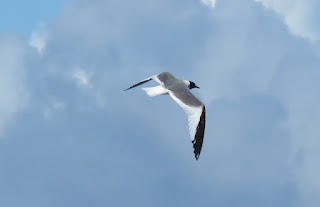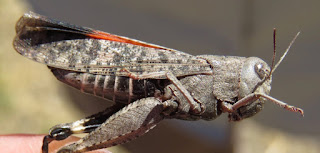This past
early September I led my fourth Oregon tour in summer. It’s actually late
summer, bordering even on early fall, considering the migration of birds well
underway, and each time I do this tour it’s a bit later. Birding is fine in
late July too, when I first offered this tour, but many birds are molting and
not so pretty then, and southbound migrants aren’t quite as numerous yet
either. An advantage over the spring tour is the opportunity to do a pelagic
trip, and we went about 25 west of Newport as a pre-tour extension. We saw the
necessary Black-footed Albatrosses and a few other tubenoses (Buller’s
Shearwater was nice to see), but the highlight for me was the large number of Sabine's
Gulls, many very close to the boat. I got just one photo.
We birded
from Portland to Corvallis on the first day of the main tour. I always take my
tours up Marys Peak at dawn, hoping for Sooty Grouse, among other birds. This
time we drove to the top then back down, then back up and back down, and on the
second pass down one grouse was in the road, a hallelujah moment. But the
weather wasn’t very good, so we returned here a second morning and had this
most cooperative of Northern Pygmy-Owls.
With better
weather, we birded some meadows and forest edge before the very top, flushing a
single Mountain Quail, then hiked to the peak itself.
We had this Lophocampa maculata, Spotted Tussock
Moth caterpillar at our picnic lunch spot on the Alsea River on the way to the
coast.
On our full
day on the coast from Florence, we made many stops, all of them stunningly
picturesque, and some with birds such as White-winged Scoter and Red-necked
Grebe.
We also made
a stop of botanical interest for Darlingtonia
californica, the California Pitcherplant, where we also had great views of
Pacific Wren.
This Wrentit
was amazingly cooperative at the Cape Perpetua Visitor Center.
Before
heading inland and over the Cascades, we had a picnic breakfast at the Siltcoos
River area. A Steller’s Jay here was a perfect mimic of Red-shouldered Hawk.
Then came
our time in utterly different eastern Oregon. Here’s the scenery at Lake Abert,
where there were hundreds of American Avocets but no Wilson’s Phalaropes.
Near there
at Summer Lake I found a rare Stilt Sandpiper, getting photos just good enough
for documentation purposes.
Another
bonus to doing a late summer tour is the chance to drive to the top of Steens
Mountain, where the views are gorgeous.
One has a
good chance of seeing Black Rosy-Finches here, but we didn’t find the flock despite
walking at least 2 miles at 9700 elevation along the rim. Still, there was
stuff to see. This is Epilobium
obcordatum, Rockfringe Willowherb.
I
specifically looked for this grasshopper, having found it here two years ago – Bradynotes obesa, Slow Mountain
Grasshopper.
This appears
to be a Steiroxys sp., katydid.
This
grasshopper is probably in the huge genus Melanoplus, and no blue-legged ones
look like this and are known from here in either Bugguide or in the grasshopper
field guide, both of which are woefully incomplete. But there are probably more
than 300 species in this genus in North American, many identifiable based on the shape of itnernal genitalia
of the male. Yet I still hope to eventually have a name for this one.
Down at
Malheur National Wildlife Refuge below Steens, we birded along the Center
Patrol Road, with the HQ still being closed to the public. This is Lycaena helloides, the Purplish Copper.
Thamnophis elegans, Western Terrestrial Garter
Snake
Crotalus oreganus lutosus, Great Basin
Rattlesnake
Sage
Thrasher
Arphia pseudonietana, Red-winged
Grasshopper
We returned
to Portland via the John Day Fossil Beds National Monument., including the
visitor center (which has the most reliable Chukar anywhere – check the
hillside behind the parking lot), and at the Painted Rocks sector, where we had
our final picnic lunch and found this Mantis
religiosa, European Mantis.
The ride
back was merely scenic, but we did stop for some quick photos of the patch of
lovely Mimulus cusickii, Cusick's
Monkeyflower.
We had
dinner within site of one of Oregon’s most beautiful sights and an iconic photo
opportunity– Multnomah Falls.





























No comments:
Post a Comment